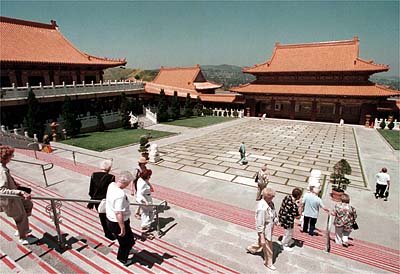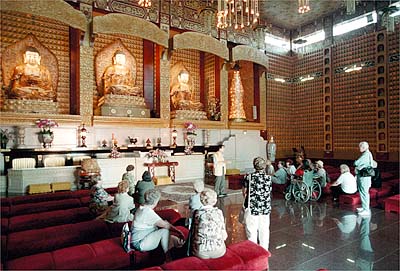April 29, 2000
Political Notoriety Puts Light on Buddhist Trend

 ACIENDA HEIGHTS, Calif., April 28 -- As a mist-laden dawn spread across this Los Angeles suburb, a group of brown-robed Buddhist monks and nuns gathered in a spacious shrine for their daily liturgy, chanting a teaching about the impermanence of matter. Around them, 10,000 tiny statues of the Buddha filled niches in the walls, and three immense Buddha figures peered benignly down from above an altar.
ACIENDA HEIGHTS, Calif., April 28 -- As a mist-laden dawn spread across this Los Angeles suburb, a group of brown-robed Buddhist monks and nuns gathered in a spacious shrine for their daily liturgy, chanting a teaching about the impermanence of matter. Around them, 10,000 tiny statues of the Buddha filled niches in the walls, and three immense Buddha figures peered benignly down from above an altar.
"In the morning, you feel your heart touch the Buddha's heart," said the Venerable Hui Chuan, vice abbot of Hsi Lai Temple, a 15-acre complex of buildings whose design replicates traditional Chinese temple architecture. "And Buddha's heart is so happy, so full of kindness."
Since its dedication 12 years ago on a hillside tract, the Hsi Lai temple has never been an obscure religious site. It is likely to become even less so in this election year, a result of its role in the Democrats' 1996 fund-raising problems. In a now-famous incident, Vice President Al Gore stopped here that year to attend a luncheon, at which, it was later disclosed, a longtime Gore fund-raiser arranged for $55,000 in illegal contributions to be made to the Democratic National Committee. (The woman, Maria Hsia, an immigration consultant, was convicted on five felony counts last month for her role in arranging illegal campaign donations to the Democrats.)
During the Democratic primaries earlier this year, Mr. Gore's opponent, former Senator Bill Bradley, cited the temple fund-raiser to try to raise doubts about Mr. Gore's integrity. It is expected that the Republican nominee, presumably Gov. George W. Bush, will do the same in the general election campaign, raising the possibility that references to the temple will show up in televised political commercials this fall.
If that happens, it may serve to call attention to an important trend within American religion, the emergence of Buddhism -- as a result of recent immigration from Asia and also conversions -- from its former image as an "alternative" faith largely associated with such bohemian literary figures as Jack Kerouac and Allen Ginsburg, to a much more mainstream status, with an estimated two million adherents.
 Hsi Lai Temple, whose name is translated as "Coming to the West," offers an example of the trend. Dedicated 12 years ago and costing nearly $30 million, it is the largest Buddhist monastery in the United States, part of an order founded in Taiwan by a monk born in China, the
Venerable Master Hsing Yun.
Hsi Lai Temple, whose name is translated as "Coming to the West," offers an example of the trend. Dedicated 12 years ago and costing nearly $30 million, it is the largest Buddhist monastery in the United States, part of an order founded in Taiwan by a monk born in China, the
Venerable Master Hsing Yun.
His original monastery in Taiwan, founded in 1967 and called Fo Guang Shan, has grown into a worldwide movement with more than 100 temples, emphasizing "humanistic Buddhism," applying the Buddha's teachings on kindness and compassion to daily life. Hsi Lai, also known as the International Buddhist Progress Society, is the largest among the movement's 19 American temples. Others can be found in Queens and Piscataway, N.J.
Stuart Chandler, a Harvard University doctoral student who has written his dissertation on Fo Guang Shan, said Master Hsing Yun oversaw one of the largest Buddhist organizations in Taiwan. Like many other Chinese Buddhists, Mr. Chandler said, it draws on two traditions, Ch'an (known as Zen in Japan), which emphasizes meditation, and Pure Land, which preaches a spiritual discipline intended to allow adherents to be re-born after death into a paradise of enlightenment.
Hsi Lai's devotees are overwhelmingly Chinese from Taiwan. But to spread Buddhism, the temple tries to reach out to native-born Americans, Mr. Chandler said, adding that the temple's invitation to Mr. Gore should probably be viewed in this context. "How better to symbolize you're O.K. to mainstream American culture than to have the vice president there?" he asked.
Among temple personnel these days, the Gore issue seems little more than a distraction. Their true interest, they say, is promoting spiritual education and culture. "Our responsibility is to the dharma," said the Venerable Man Yee, one of the nuns, referring to the essential teachings of Buddhism. "That is the main purpose of our Master Hsing Yun, to propagate the dharma and educate the culture."
The Venerable Hui Chuan said: "There are media-press that will only focus on the political parts. But Hsi Lai Temple is a multifunctioning temple." Its intention, he said, is to "make Buddhism Americanized," ensure that a new generation of Chinese in the United States know their Buddhist heritage and that the temple itself functions as a cultural bridge between East and West.
To that end, Hsi Lai is designed to be accessible to people with little knowledge of Buddhism or Chinese culture. Maps are available of the temple complex, which is laid out as an elongated triangle, a shape intended to resemble the leaf of a bodhi tree -- the tree under which the Buddha sat when he attained enlightenment 2,500 years ago.
Throughout the grounds, signs in English and Chinese offer explanations of statues and buildings. Visitors may join a daily tour or pick up a cassette tape player at the temple's information desk for a self-guided walk. A rack provides free pamphlets of Master Hsing Yun's lectures, with such titles as "The Essence of Buddhism" and "A Guide for Young Buddhists."
There are also Sunday morning, English-language classes on Buddhist principles. Citing them, temple personnel say publicity about the Gore visit may actually have helped, in arousing public curiosity. "We've had more people join the English dharma class," said the Venerable Man Yee, who once worked as a real estate agent in Toronto.
More tangible signs of the temple's ambitions can be found in nearby communities. A 20-minute drive away, in Rosemead, the temple has bought a cluster of classroom buildings once owned by the Methodists to serve as the campus of Hsi Lai University, offering degrees in Buddhism, religious studies and business administration, as well as courses in English as a second language. Its president, Naichen Chen, said the institution had 350 students, having begun with a handful a decade ago, when classes held were at the temple. This year, it began publishing a scholarly journal on Buddhism.
The dean of students, Ananda W. P. Guruge, a former ambassador to the United States from Sri Lanka, said he found the political attention paid to the temple to be "very hurtful," but Mr. Guruge predicted that it would result in no lasting damage to the image of Buddhists in the United States.
Michael Murry, the university's database administrator, said he and other Buddhists regarded the negative publicity as an opportunity to practice values of their faith. "It just gives people a chance to shine by putting up with it," Mr. Murry said, "because Buddhism is very tolerant."
Not far away, the temple's most recent project sits atop a ridge in Whittier, Calif., a city settled by Quakers, and where former President Richard M. Nixon went to college. On the grounds of the Rose Hills Memorial Park, the temple has built an elegant, three-story pagoda, with orange tile roofs and brass bas-reliefs of the Buddha. It is a columbarium, with 25,000 niches, each to hold an urn containing the ashes of the dead. The building's balconies afford expansive views of the Los Angeles basin and, to the east, the San Gabriel Valley. "It's the largest Chinese Buddhist pagoda in North America," said a young woman who guided a visitor around, adding, "at this time."